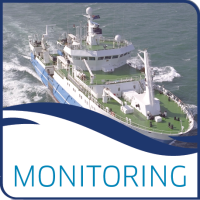Scottish Marine and Freshwater Science Vo 8 No 9
Polycyclic aromatic hydrocarbon (PAHs) were measured in environmental samples (water, fish and sediment) collected in 2014 and 2016 from the Faroe-Shetland Channel and Rosemary Bank Seamount. These data could be used to provide a baseline against which any changes can be assessed in the event of an oil spill and contribute to any environmental impact assessment. Concentrations in all samples were low, often below the detection limits, and were typical of reference sites. Sponges can be used as an alternative indicator species to mussels for monitoring PAHs in the marine environment as they can accumulate PAHs from both the dissolved and particulate phase. PAH concentrations in marine sponges from Scottish waters have not previously been reported. Concentrations were low, but contained a higher proportion of heavier 4- to 6-ring PAHs compared to the fish samples.
Data and Resources
- MoreDeep PAH Datacsv
Please consult the PDF report in this dataset for full details on...
Preview Download
| Field | Value |
|---|---|
| Publisher | |
| Modified | 2020-01-07 |
| Release Date | 2017-06-08 |
| Identifier | 450578d1-6ab7-4afd-b1a5-33dfdb3ed12f |
| Spatial / Geographical Coverage Location | Scotland |
| Temporal Coverage | 2014-01-01 to 2016-12-31 |
| License | UK Open Government Licence (OGL) |
| Author | |
| Data Dictionary | Samples were collected from the Faroe-Shetland Channel (FSC) and from a control area on the Rosemary Bank Seamount (RBS) during September 2014 and again in September 2016 (Fig. 1) from the MRV Scotia. Water samples were collected from 1 and 10 metre depths at each site using a reverser bottle and transferred into pre-cleaned glass bottles (2.5 l). Samples were preserved by the addition of dichloromethane (100 ml) and kept at room temperature before extraction. Fish were collected at each station using a bottom trawl. The species collected are shown in Table 1. In 2014 trawling was carried out at three locations along the FSC, Box 1-3, and at the control location, RBS (Figure 1). Five fish of each species were collected from each of the sites. Not all of the species were caught at each of the locations. These samples were stored at -20±5oC prior to analysis. The fish were gutted and placed on ice for 24 hours prior to filleting. Fillets were wrapped in aluminium foil with one fillet from each fish blast frozen before all fillets were transferred to the freezer and stored at - 20± 5 °C until required. The blast frozen fillet from each fish was for sensory assessment. Pools of five livers and five fillets were placed in solvent washed aluminium cans for hydrocarbon analysis. In addition, samples of sponges were collected using the bottom trawl from RBS in 2014. In 2016 fish and sponges were collected from RBS only, the FSC could not be sampled due to poor weather conditions. Fish species collected in 2016 included blue Ling (Molva dypterygia), black scabbard (Aphanopus carbo), blue whiting (Micromesistius poutassou) and round nose grenadier (Coryphaenoides rupestris). Collecting sediment in deep water cannot be done using the normal Day Grab sampler as it takes too long for the grab to reach the seafloor. However, sediment samples were collected from the trawl doors in Box 1 and Box 2 in 2014 and from Rosemary Bank in 2016. The sediment was transferred to solvent washed aluminium cans and frozen (-20±5oC) until required for analysis. |
| Contact Name | Marine Scotland Science |
| Contact Email | |
| Public Access Level | Public |


